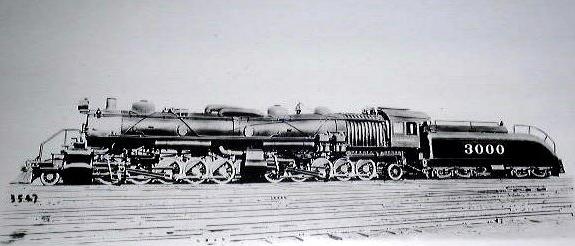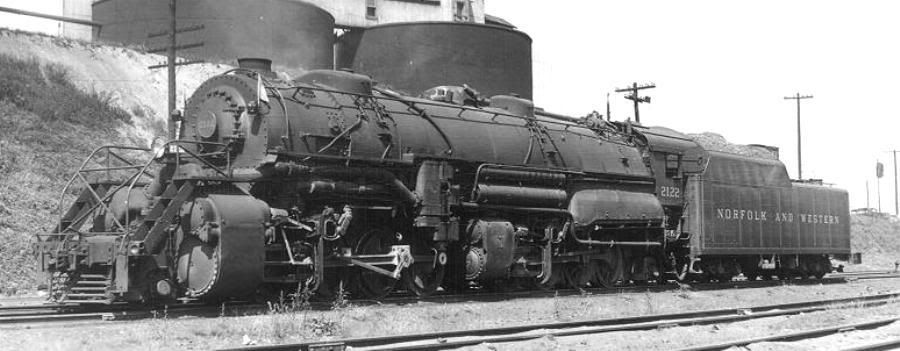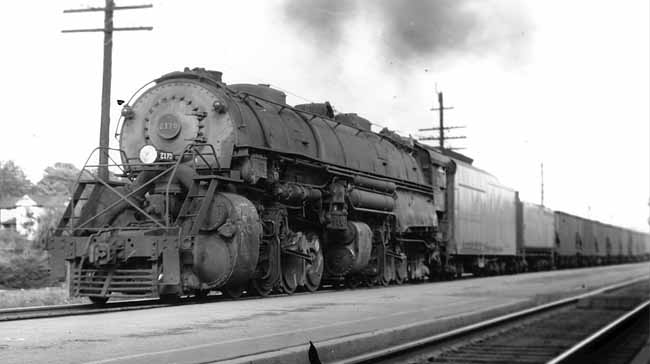KGBW, Doc, sam, et al.: great pictures!! Thanks!
The SP 4-10-2’s were not hangar queens, but they were maintenance intensive, even by steam standards. There is a well-known tale about the SP mechanic who was kept on the payroll despite numerous Rule G violations since he knew how to set the valve events on three-cylinder 4-10-2’s.
Restore a 4-12-2?? It isn’t going to happen, where would you get the money and where could you run it.
An SP mechanical officer described maintenance costs for the three cylinder engines “is like having an expensive mistress at every Division point.”
Broadside view of ATSF 2-10-10-2…

Virginian 2-10-10-2 for comparison - these had much longer lives than the ATSF units…

Virginian 2-10-10-2 on freight - while all compound articulateds had large front cylinders, these seem to be even larger than on something like the N&W Y6b…

A pair of 2-10-10-2s in helper service…

A grainy shot that shows the large front cylinders…

N&W Y6a for comparison…

Y6b…

Y5 in the company notch…

Regarding the size of the low-pressure cylinders on the VGN 2-10-10-2’s: they were so large that they had to be loaded on separate flat cars when the locomotives were shipped for the builder since they would otherwise exceed clearances on the various connecting roads.
Description and some good pictures of the Virginian locomotives are available here (starting on p.166); the book is available as a ‘free download’ in the United States from Google Books if you want a copy. Note the head-on picture that shows the cylinder diameter to particular advantage – shades of unitary machinery support!
Those tenders look so tiny, especially on the Virginian.
Just a minor clarification about SP 5021 as I was involved with its acquisition and placement in the Los Angeles County Fairgrounds in 1956. The Southern California Chapter of the Railway & Locomotive Historical Society realizing that it was the last of the three-cylinder 4-10-2s, put in a request to the Southern Pacific for the opportunity to preserve 5021. SP management knew we already had three small locomotives and Santa Fe 4-6-4 3450 in our exhibit, so they agreed to donate the 5021. It was at that time in service on the Portland division, and shortly before its flues were to expire, SP ran it as a light engine move to Los Angeles in December 1955. It was stored at Taylor roundhouse for a short period before going into Los Angeles General Shops where it was given a first class cleaning and painting, with chrome in many areas not normally seen. The locomotive was moved dead over the SP to Bassett and then a Pacific Electric spur into the fairgrounds to the exhibit. A presentation ceremony was made in the spring of 1956. Thousands of fairgoers come through the Chapter exhibit, and Union Paciific 4-12-2 was added in May of 1956. The truly amazing thing about the UP 9000 is, that through the efforts of the late Allen Krieg, Chapter Director and UP Public Relations Manager, The 9000, a coal burner, came from Cheyenne to Los Angeles under is own power!
Today you can visit this exhibit at FAIRPLEX and see two of the only remaining three-cylinder, rigid frame steam locomotives in the United States.
Great information and stories, thanks! But those two are not the only US-built 3-cylinder locomotives left. Two more survived, the A&S 0-8-0 in St. Louis and the 4-10-2 Baldwin demonstrator in the Franklin Institute.
MrATSF, thank you, thank you, thank you for your efforts! In a past life living in Southern CA I had the opportunity to visit the Fairplex and see 5021 and 9000, and they were both great examples of “bigger, better, faster” and the “can do” American spirit. Just great locomotives!
I never understood why 9000 was sent to California for preservation, since the class never operated there in regular service. It has always seemed that an oil burner such as 5511, and/or an oil burning Challenger or 4-8-4 would be more appropriate, since they did commonly operate in California. Wouldn’t the 9000 be more appropriately displayed in Cheyenne, or nearby?
Tom
There are so many “what if” and “why didn’t they” situations.
Why didn’t SP preserve 4-8-4 4458 or 4459 - the roller-bearing-equipped units - say one in LA and one in Oakland or Fresno?
Why didn’t UP preserve a 4-8-4 in Southern CA, or another Challenger?
Why didn’t NP preserve an A-4 or A-5 4-8-4 in Minneapolis?
What if NYC had preserved one each of their “Big Three” - a J3a Hudson, an L4b Mohawk and a Niagara?
What if GN had preserved an R-2 2-8-8-2, or Southern a couple more PS-4 Pacifics, or MILW an F-7 4-6-4 Baltic or CNW a 4-8-4 Zeppelin?
What if IC had preserved 4-8-2 2613?
I am sure everyone can add to the list.
The sad thing is saving those locomotives would not even have moved the needle on the carrier’s bottom line in the year they were scrapped.
Thankfully UP 9000 is around in Southern CA and SP 4460 is around in St. Louis and many others are out there, far from home rails but at least still around.
But indeed - What if???
I suspect the bigger reason locomotives weren’t saved in the locations you named is that there was very little if any civic desire in those communities to provide locations for them to be preserved. Saving locomotives requires the cooperation of both the carriers and the communities.
Sad but true!
Lack of a location or willing recipient was a factor in many cases, but it sure doesn’t explain the B&O Railroad’s major miscommunication when it scrapped the last EM-1 2-8-8-4 after promising it to ITS OWN MUSEUM!
Tom
Have any 2-10-10-2 Steam Locomotives been redone and released in plastic yet?
Lord, no! How many of them do you think you would sell?
I don’t even think there’s much of a market in specialty brass for one of these things. Here is a page showing the Westside brass model and you can guess how long it’s been without a reissue…
Even ATSF didn’t keep them long (recognizing that as with the ‘added motor units’ from Baldwin, the articulated chassis could be much better used under its own separate boiler – the firebox on the 2-10-10-2s was barely adequate even for the 2-10-2 directly, tandem compound water-rate saving or not).
Is there a market in plastic for an early-20th-Century heavy locomotive with weird firebox that can’t be run effectively on almost any layout? I think the right answer would have to be to publish Shapeways files that would let interested modelers make originals to rework for epoxy resin castings – or see if one of the boutique makers like Dave Grover’s Eddystone would do the basic work for you.
Yes, I’d like to see someone make these in a cost-effective form. No, I don’t think anyone making these would sell them at any approximation of a cost-effective cost. Nor do I think you’d get enough reservations to convince any for-profit manufacturer to invest the time and money to make a production quantity.
The Santa Fe 2-10-10-2 was produced as a limited production HO brass model some time around the 1970’s. I understand it could get around curves in one direction ony because the piping got in the way. I don’t know what the minimum radius was. The prototype engines were impractical, short-lived, used in very limited territory, and pretty ugly in the opinion of most observers. With all of those things going against them, it’s not likely that any manufacturer will produce a model nowadays.
Tom
AC, I really admire you as a sorce of solid information!
The brass model as much as shows what was wrong with the prototype and why it didn’t steam right. To say a locomotive is ugly is not a technical argument, but it perhaps reflects an intuition that the proportions are out of whack.
There are certain rules steam locomotive designers came up with regarding relative proportions of the grate, firebox, tubes, and firebox sections of the boiler. If that model does one thing, it gives one a better sense of those proportions than the few extant photographs. The model proportions suggest that this locomotive was just “thrown” together without taking those design rules into account.